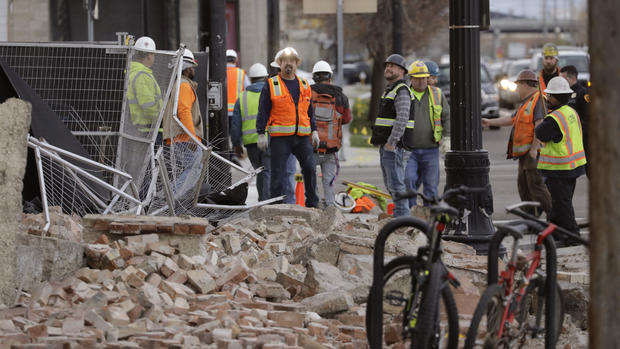
Repair efforts are underway in Salt Lake City to clear debris from a 5.7 magnitude earthquake.
LOGAN – The early morning earthquake that had the Salt Lake City area all shook up was only a “small to moderate seismic event,” according Utah State University engineering expert Dr. Marv Halling.
Halling said that the news reports coming out of Salt Lake, which are noting some minor damage to city structures with no serious injuries, are typical of the aftermath of that kind of seismic event.
“This event is significant mainly because we don’t have even moderate earthquakes in Utah very often,” Halling said, “particularly not so close to major population centers.”
The 5.7 magnitude earthquake hit at 7:09 a.m. this morning, according to the seismograph station at the University of Utah.
Anecdotal reports indicate the tremor was felt as far north as Preston, ID, as far south as American Fork, and as far east as the Bear Lake area. Reports of damage have been generally limited to an area stretching west from Salt Lake through West Valley City to Magna and Station Park in Tooele County.
According to the University of Utah seismologists, the epicenter of the quake was about three miles north of Magna at a depth of about six miles underground. An aftershock with a magnitude of 3.7 on the Richter scale was felt at 7:15 a.m. and numerous other tremors followed, with the most powerful of those shocks registering a magnitude of 4.4.
From the USU Department of Civil & Environmental Engineering, Halling said he doubted that the aftershocks will result in any additional damage.
“Aftershocks could continue for a period of weeks or months,” Halling acknowledged, “but only in about 10 percent of earthquakes do we see an aftershock that’s actually more powerful than the original tremor.”
The Richter scale is a numerical method of expressing the magnitude of an earthquake on the basis of seismograph oscillations. More destructive earthquakes typically have magnitudes between about 5.9 and 8.9. The Richter scale is logarithmic and a difference of one point represents an approximate thirtyfold increase in potentially damaging magnitude.
No damage has been reported here in the Cache Valley from the quake. Closer to the epicenter in Salt Lake, media reports indicate that some damage to structures has occurred. Power outages affecting an estimated 55,000 Rocky Mountain Power customers in Salt Lake and Tooele counties have also been reported.
While damage to the city’s infrastructure is being accessed, TRAX and Frontrunner trains have been stalled. Flights from the Salt Lake International Airport have also been suspended due to damage to its control tower and terminal buildings.
A spokesman for the Church of Jesus Christ of Latter-day Saints confirmed that the earthquake caused minor damage to the church’s temple in Salt Lake City. That damage included dislodging an iconic temple symbol — the trumpet of an angel statue atop its highest spire.
Gov. Gary Herbert has requested that citizens avoid the downtown area to facilitate the efforts of emergency repair crews and city hall officials have echoed that guidance.
The State Lab at the Utah Department of Health is closed, as is the State Poison Control Center. The quake damage has also disrupted the activities of Utah Coronavirus Task Force, including cancelling the task force’s daily news conference.
University of Utah officials indicated that this quake was the largest tremor felt in Utah since 1992, when a similar powerful earthquake was felt in the area of St. George.

